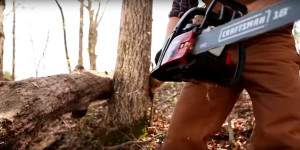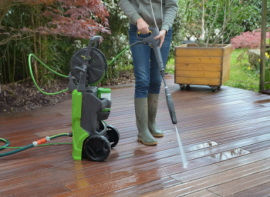- Kenmore refrigerator water filters
- Whirlpool refrigerator water filters
- Samsung refrigerator water filters
- GE refrigerator water filters
- LG refrigerator water filters
- Frigidaire refrigerator water filters
- KitchenAid refrigerator water filters
- Maytag refrigerator water filters
- Kenmore Elite refrigerator water filters
- Estate refrigerator water filters
- GE Profile refrigerator water filters
- Amana refrigerator water filters
- Bosch refrigerator water filters
- Dacor refrigerator water filters
- Electrolux refrigerator water filters
How to cut trees, limbs and branches with a chainsaw


Chainsaws are powerful tools when you want to cut down a tree or chop up a tree that toppled during a storm. When you're using a chainsaw to cut a tree or tree limb, two things make the job easier and safer: use the design of the chainsaw and the weight of the tree or tree limb to your advantage. And always keep the chain sharp.
For advice on repairing a chainsaw, see our chainsaw repair help.
Cutting tips
Before you start cutting, keep these tips in mind:
Whether you're cutting down a tree, cutting a fallen limb or trimming small, low branches from a tree, run the chainsaw at full speed. It's not only faster, it's safer. Running at high speed reduces the chance of the chain binding and causing the chainsaw to fly back at you.
When you start up a chainsaw, make sure the chain oiler is working the way it should. The oiler shoots a thin cushion of oil between the chain and the guide bar, and without it, both would overheat and be ruined.
To check that the oiler is working properly, put newspaper under the chainsaw and pull the trigger to bring the chainsaw to full speed. Oil should splatter onto the paper. If not, clean out the oil ports in the bar as directed in your owner's manual.
Chains dull quickly—you know the chain is sharp if it creates chips as it cuts. If you see chainsaw dust instead of chips, it means the chain is dull. Stop immediately and sharpen it.
Chain sharpening requires special tools to ensure that cutters are sharpened at the correct angle and depth. If you're an inexperienced chainsaw user, have the chain professionally sharpened. If you feel comfortable sharpening your own chainsaw chain, you can do it yourself.
Cutting down a tree
Have at least two safety zones you can move to as the tree begins to fall. The first safety zone should be directly opposite where you expect the tree to fall. The second should be a place you can get to if the tree unexpectedly falls toward you. There should be no people, pets or objects within 2-1/2 tree lengths of the tree.
To start, cut a notch at a comfortable working height on the side toward the desired direction of fall. If the tree is leaning or appears to have more limbs or limbs of greater weight on one side, cut the notch in the the leaning or heavy side.
Make the first cut so it slopes toward the ground and goes about one-third of the way through the tree. Finish the notch with a cut from below that angles up toward the first cut, and remove the wedge of wood the cuts created.
Finish the job from the other side of the tree, starting about 2 inches above the point of the notch. On larger trees, turn off the chainsaw partway through the cut, remove it from the tree, and drive wood or plastic wedges into the cut to keep it open. Restart the chainsaw and carefully put it back in the cut, being careful not to do any cutting with the tip—cuts along the tip can cause the chainsaw to kick back at you.
The tree starts falling before you've cut all the way through, with the uncut section acting as a hinge that slows the fall and controls its direction. As soon as the tree starts to fall, turn off the chainsaw, put it on the ground and move quickly into the appropriate safety zone.
Cutting fallen limbs
When cutting a falling limb, ideally you should rest the limb on a chainsaw buck with a pair of X-shaped legs. That way, you can cut without bending over, the chain won't hit the ground and the chainsaw is less likely to bind inside the slide when the slice compresses. If the limb is too heavy to lift onto a chainsaw buck, or if you don't have a chainsaw buck handy, cut so that the chain won't dip into the ground and get dull. Start cutting from the top, cutting about one-third of the way through the log. Roll the log over and finish with a second cut. Cut small branches in one cut, but cut larger pieces in two cuts to avoid pinching the chain inside the cut. Here's how:
When cutting a log suspended between two points—such as on a saw buck, or across a ditch—start the cut on the top and cut part way through. Finish the cut from below, cutting straight up into the initial cut.
When cutting a log suspended from a single point—like leaning against a house—start the cut from below, and finish from above. This method keeps the chain from getting pinched as the log droops.
When cutting large limbs from a fallen tree, start cutting from the base of the tree and work your way toward the top, so that the uncut limbs point away from you instead of getting in your way. Cut through branches that are parallel to the ground from above. Cut through other branches as if you were pruning the tree. Don't cut large limbs from a standing tree—it's too dangerous. Call a professional.
Trimming small branches from a tree
You can use a chainsaw to trim small branches from a tree, as long as you don't have to hold the chainsaw higher than shoulder level.
To prevent the falling branch from tearing the bark from the trunk as it falls, make a cut a foot or so from the trunk and cut from below the branch, so that the limb sags. Move a few inches further away from the tree and cut all the way through the branch from above. Any tearing that occurs stops when it reaches the first cut. Make a third cut close to the trunk to cut off the stub left by the second cut.
Jeff Day is a freelance writer.
Symptoms for gas chainsaws
Choose a symptom to see related chainsaw repairs.
Main causes: stale gasoline, cracked fuel lines, dirty carburetor, damaged spark plug, worn piston rings…
Main causes: bad gas, engine needs tune up, cracked fuel lines, dirty carburetor…
Main causes: cracked fuel lines, leaky carburetor seals, damaged fuel tank cap, cracked fuel tank…
Repair guides for gas chainsaws
These step-by-step repair guides will help you safely fix what’s broken on your chainsaw.

How to rebuild a chainsaw carburetor
If your chainsaw isn't running well, a dirty carburetor could be the problem. You can take it apart, clean it and rebuil…
Repair difficulty
Time required
15 minutes or less

How to replace chainsaw fuel lines
The fuel line on a chainsaw becomes brittle over time and can crack. Replacing it doesn't require a lot of DYI experienc…
Repair difficulty
Time required
15 minutes or less

How to replace a chainsaw carburetor
If the engine won't start even though there's fuel in the chainsaw, the carburetor could be the problem. Sometimes, it's…
Repair difficulty
Time required
15 minutes or less
Articles and videos for gas chainsaws
Use the advice and tips in these articles and videos to get the most out of your chainsaw.

Learn about the top 10 must-have electric lawn & garden tools for 2023…

Learn about all the convenient features on our Sears PartsDirect website that make your parts purchases easier.…

Get answers to frequently asked questions about Sears and Sears PartsDirect.…